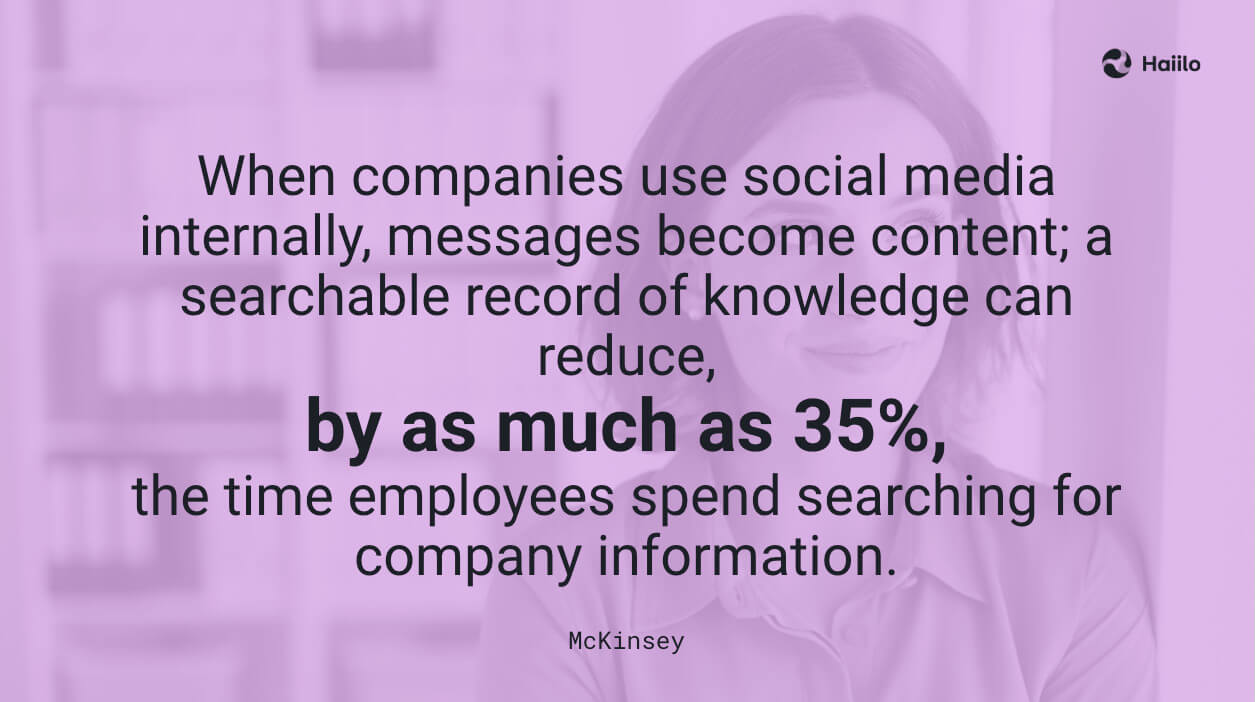Understanding your intranet’s ROI is important for building a solid use case for the new investment. When it comes to social intranets, it is critical that organizations evaluate a number of different factors that have a direct or indirect impact on the overall intranet ROI.
As nicely explained in a research by McKinsey:
While 72% of companies use social technologies in some way, very few are anywhere near to achieving the full potential benefit. In fact, the most powerful applications of social technologies in the global economy are largely untapped…the McKinsey Global Institute (MGI) finds that twice as much potential value lies in using social tools to enhance communications, knowledge sharing, and collaboration within and across enterprises.
These technologies create significant value for organizations by improving productivity across the value chain, and they could potentially contribute $900 billion to $1.3 trillion in annual value.

Even though calculating exact intranet ROI is quite difficult, we will try to help you get started. In fact, measuring the precise value of an intranet is likely impossible, but we can help you better understand the factors that contribute to getting the best possible intranet ROI.
- 1. Turnkey vs. Homegrown
- 2. Employee Engagement, Productivity, and Retention
- 3. Information Overload and Knowledge Management
- 4. Workplace Collaboration
- 5. Employee Onboarding
- 6. Ease of Use, Implementation, Maintenance
- 7. Scalability
- 8. Integrations with Other Workplace Tech Stack
- 9. AI-Powered Capabilities
- 10. Extended Features and Functionalities
1. Turnkey vs. Homegrown
When measuring intranet ROI or building a business case for implementing a new intranet solution in your company, it’s important to differentiate between ready-made turnkey solutions available on the market and building an intranet in-house.
The cost of building an intranet from scratch is extremely high. This is why intranet buyers’ demand has shifted away from “build” to “buy.” Today’s turnkey intranets are software-as-a-service platforms designed for the communicators, HR professionals, designers, and authors who are responsible for creating relevant, tailored information for employees in an any work environment.
Because it took years for intranet vendors to design and develop perfect solutions, it can take years and extensive resources to build an in-house intranet. On the other hand, according to G2, software businesses are facing pressures to show results and are urging vendors to not just tell them how their offerings can drive value but show them—within 6 months.
Get the best intranet ROI with Haiilo!
2. Employee Engagement, Productivity, and Retention
Internal communications have a direct and strong impact on employee engagement. And overall, companies with high employee engagement are 21% more profitable which is the consequence of numerous positive outcomes of high engagement at work. Some of these include less absenteeism, fewer workplace accidents, more innovation, better customer experience, and lower employee turnover.
But what roles does an intranet play in improving the overall employee engagement?
By streamlining daily processes and procedures, making information readily available and accessible to everyone, and opening two-way communication between and among peers and managers, you can improve the overall employee experience, hence making employees more motivated.
When set up properly, intranets can serve as the biggest productivity boosters in modern organizations. They can help workers improve email treatment management, reduce the number of meetings, and cut time wasted searching for information.
Another benchmark for your intranet ROI is powerful built-in and AI-powered analytics, which helps organizations measure the engagement of various company programs and initiatives. Content statistics, readership, employee reactions, audience insights, search metrics, and interactions with posts can give you valuable insights and actionable recommendations for improvement.
Furthermore, low employee engagement results in high employee turnover, and turnover can be extremely costly. According to Gallup, the cost of replacing an employee can range from one-half to two times the employee’s annual salary.
📹 Check out our Masterclass about how to drive employee engagement in the workplace.
3. Information Overload and Knowledge Management
According to McKinsey, the average worker spends 20% of the workweek tracking down information and people to find answers. Moreover, 8% of the workweek employees spend just sifting through inboxes.
So better information and knowledge management is critical for boosting employee productivity, and social employee intranets are the perfect solution for this. For example, Haiilo’s Content Lifecycle Management makes it easy to keep content pieces in your digital home up to date. It helps identify and eliminate duplicates or outdated information and more.
According to research, by using social technologies, companies can raise the productivity of knowledge workers by 20 to 25%.
McKinsey’s research found that when companies use social media internally, messages become content; a searchable record of knowledge can reduce, by as much as 35%, the time employees spend searching for company information. The results are visible through faster, more efficient, and more effective workplace collaboration.

4. Workplace Collaboration
When evaluating intranet ROI it’s important to understand how it improves the overall workplace collaboration and team communication.
With the emergence of remote and hybrid work, collaboration and communication have become the biggest struggles for many employees across the globe. The inability to always stay connected with peers makes cross-functional collaboration extremely difficult.
Even though most companies use instant messaging solutions to communicate asynchronously, the lifespan of these messages and information is short causing frustrations among teams working on the same projects.
One of the most popular use cases that prove the power of intranet-like social workplace technologies is the one by Cosco. When Cisco implemented new collaboration tools and internal processes for their 80,000 employees, they saw a 9x return on investment.
5. Employee Onboarding
Intranets are heavily used to improve employees’ preboarding and onboarding experience and efficiency. Since employee onboarding can be quite expensive, taking it into consideration when calculating intranet ROI is critical.
According to research, it costs at least $4,000 to onboard a new hire. So it’s critical to make onboarding as streamlined and as effective as possible. By centralizing forms, training videos, important documents, and policies and procedures sets a uniform experience for every new person. Consequently, onboarding becomes much faster and more enjoyable for everyone.
According to Forrester, when intranets are effectively used, organizations can decrease the employee onboarding time by an average of 20%. This not only alleviates internal resources, but also quickly aligns your new team members to processes, and company culture, and sets them up for success.
6. Ease of Use, Implementation, Maintenance
Some intranets are easier to implement and maintain the others. Because implementation can make a significant portion of the overall intranet expense, it also impacts the overall intranet ROI.
For some intranet providers, the costs start with licenses. Consultation hours, implementation support, logistical help, customization services, and employee training are some of the added expenses to keep a platform running. Very quickly, thousands of dollars can be added to the initial investment.
So when choosing an intranet vendor, make sure that the implementation processes and expenses are reasonable and that there are no hidden costs. According to G2, enterprise software buyers are pressured to show the value of the new investment fast. So fast implementation is critical for them. According to the research, of those who purchased shadow IT, medium-sized companies (87%) and enterprises (93%) did so because they needed to move quickly.
Furthermore, many intranets on the market lack the intuitiveness needed for the best possible user adoption.
In fact, user adoption is a key concern for organizations considering any new workplace solutions. According to a study by 1E, US companies wasted $30 billion on rarely used or unused software over the span of four years.

With intranets, user adoption is critical for ensuring the highest intranet ROI. To ensure great user adoption, the intranet’s interface needs to be intuitive, helpful, and fun to use. Furthermore, the platform needs to be accessible to every employee, even to frontline workers without a designated working space or company email. So make sure that the intranet provider offers a native mobile employee app for those workers who are always on the go.
7. Scalability
It’s important that your intranet lets you scale confidently. Meaning, your intranet should be able to easily grow as your company grows. Unfortunately, not many intranet providers are flexible, resulting in additional intranet expenses when the growth happens.
Adding new users to your intranet platform should be seamless, extending new features and functionalities shouldn’t take years, and expanding your server space should be easy to do.
Additionally, advanced intranet solutions make it easier to scale by offering powerful built-in solutions such as employee advocacy, employee surveys, and analytics with valuable insights and actionable recommendations for improvement (more about extensibility later in the blog).
To achieve such flexibility and a better intranet ROI, make sure that you look for a flexible and extensible cloud-based solution.
Furthermore, many vendors on the market offer volume discounts for scaling companies or large enterprises. The more users your company needs the lower the price per user.
8. Integrations with Other Workplace Tech Stack
The role of an intranet is to become the ultimate digital home for every employee. A place from which every employee starts their day.
To build such a single source of truth, it is important that the intranet integrates with other critical workplace tech your company uses. Integrations with Google Workspace, Microsoft 365, Teams, Slack, Trello, and other project management and communication tools are an absolute must.
This way, employees can have all the important events, information, tasks, tools, people, and documents in a single view.
If this is not achieved, the intranet becomes just another workplace tool with no added value for the company – it becomes an expense rather than an investment. In fact, 82% of respondents in the G2 research mention it is important to them that the software they buy integrates with their existing solutions. Buyers rank ease of integration higher than the cost of the software, the kind of security it provides, or its TCO.

Besides native integrations, look for a vendor that offers open API access so that you can integrate your intranet with any software your employees use. Solutions that grant you access to their API are the best choice because this allows you to build your own integrations when they don’t already exist. This way, you can ensure your internet works with every tool your employees need.
💡 Related: What is an Employee Engagement App and Why Your Company Needs One
9. AI-Powered Capabilities
In a previously mentioned research by G2, 81% of respondents say that it is important or very important that the software they purchase moving forward has AI functionality. Organizations are well aware of the benefits of AI.
With the emergence of Chat GPT, the popularity of AI in marketing, sales, HR, and internal communications departments has become even more significant.
In the previous sections, we mainly talked about the benefits of intranet for employees who consume content. But how about the content creators, human resources departments and internal comms functions?
AI-powered intranets can help these content creators become much more efficient and create content 10x faster, hence having a direct impact on the intranet ROI.
Haiilo’s AVA can create content drafts based on the topic of interest. After this, it can adjust the tone and voice of the article to match your company style, make the content shorter or longer, and automatically generate relevant hashtags.
10. Extended Features and Functionalities
Some intranet providers have built-in features and functionalities that can help you replace some of your existing tech stack providers, cut your company’s tech expenses, or serve as an added revenue stream for your organization.
According to research, software buyers prefer to work with fewer vendors (78%) and use a single solution instead of multiple tools (84%). When multiple solutions are required, 77% of buyers prefer to buy complementary products from the vendors they already work with.
This is where Haiilo comes in very handy. It comes with features and functionalities that can replace survey solutions to measure employees’ pulse, and employee advocacy solutions, and it can even serve as a social recognition tool.
If we know that leads generated through employee social marketing convert 7 times more frequently than other leads, then it’s clear that employee advocacy capabilities can significantly increase your intranet’s ROI.










